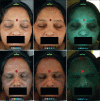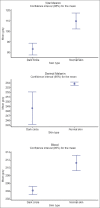Determination of Melanin and Haemoglobin in the Skin of Idiopathic Cutaneous Hyperchromia of the Orbital region (ICHOR): A Study of Indian Patients
- PMID: 23112512
- PMCID: PMC3483573
- DOI: 10.4103/0974-2077.101371
Determination of Melanin and Haemoglobin in the Skin of Idiopathic Cutaneous Hyperchromia of the Orbital region (ICHOR): A Study of Indian Patients
Abstract
Background: Idiopathic cutaneous hyperchromia at the orbital region (ICHOR) is a cutaneous hyperchromia characterised by bilateral darkening of the eyelid and orbital skin that contrasts with the adjoining facial skin. ICHOR is frequent in dark skin. It interferes with the face appearance which often causes difficulties in societal acceptance and may impact quality of life.
Objective: The aim of this investigation was to study the epidemiology, clinical features and risk factors associated with ICHOR in Indian patients and also to study the distribution of melanin and haemoglobin in ICHOR patients. This study also assessed the relevance of SIAscopy technique (spectrophotometric intracutaneous analysis (SIA)), a new objective non-invasive method to measure melanin and haemoglobin concentration in vivo.
Materials and methods: Thirty-three patients diagnosed with ICHOR at the All India Institute of Medical Sciences, New Dehli, India, were included in the study. Epidemiological data were collected through a self-administrated questionnaire. Standard photographs were taken from each patient and SIAscopy measurements were done on dark circles and normal skin.
Results: Surprisingly our study showed no significant correlation between ICHOR prevalence and family history, atopic and contact dermatitis, contemporaneous melasma and hormonal factors. The study confirms that sun exposure is a risk factor of dark circles aggravation. Indeed patients tend to reduce sun exposure after the onset of dark circles. SIAscopy analysis reveals significant differences in the concentration of total melanin, of dermal melanin and of haemoglobin between ICHOR skin and normal skin of the same patient.
Conclusion: This study confirms that melanin deposits and blood stasis in dark circles may play a role in ICHOR pathogenesis and cause the darkening of skin under eyes. SIAscopy provides objective diagnostic information about ICHOR.
Keywords: Idiopathic cutaneous hyperchromia of the orbital region; dark circles around the eyes; periorbital pigmentation.
Conflict of interest statement
Figures



Similar articles
-
Treatment of idiopathic cutaneous hyperchromia of the orbital region (ICHOR) with intense pulsed light.Dermatol Surg. 2006 Jun;32(6):773-83; discussion 783-4. doi: 10.1111/j.1524-4725.2006.32160.x. Dermatol Surg. 2006. PMID: 16792641
-
Physiological and lifestyle factors contributing to risk and severity of peri-orbital dark circles in the Brazilian population.An Bras Dermatol. 2015 Jul-Aug;90(4):494-503. doi: 10.1590/abd1806-4841.20153520. An Bras Dermatol. 2015. PMID: 26375218 Free PMC article.
-
Treatments of Periorbital Hyperpigmentation: A Systematic Review.Dermatol Surg. 2021 Jan 1;47(1):70-74. doi: 10.1097/DSS.0000000000002484. Dermatol Surg. 2021. PMID: 32740208
-
Cutaneous idiopathic hyperchromia of the orbital region (CIHOR): a histopathological study.Aesthetic Plast Surg. 2013 Apr;37(2):434-8. doi: 10.1007/s00266-012-0048-2. Epub 2013 Jan 24. Aesthetic Plast Surg. 2013. PMID: 23344465
-
What causes dark circles under the eyes?J Cosmet Dermatol. 2007 Sep;6(3):211-5. doi: 10.1111/j.1473-2165.2007.00324.x. J Cosmet Dermatol. 2007. PMID: 17760701 Review.
Cited by
-
The Impact of Carboxytherapy and Treatments Combining Carboxytherapy and Selected Chemical Peels on Vascular and Pigmentary Components of the Dark Circles.Clin Cosmet Investig Dermatol. 2024 Aug 23;17:1875-1885. doi: 10.2147/CCID.S469708. eCollection 2024. Clin Cosmet Investig Dermatol. 2024. PMID: 39193094 Free PMC article.
-
Cell-Free Fat Extract with Anti-melanogenic Property Improves the Appearance of Infraorbital Dark Circles: A Preliminary Clinical Study.Aesthetic Plast Surg. 2025 Mar;49(5):1526-1535. doi: 10.1007/s00266-024-04445-9. Epub 2024 Nov 12. Aesthetic Plast Surg. 2025. PMID: 39532743
-
Idiopathic cutaneous hyperchromia at the orbital region or periorbital hyperpigmentation.J Cutan Aesthet Surg. 2012 Jul;5(3):183-4. J Cutan Aesthet Surg. 2012. PMID: 23112513 Free PMC article. No abstract available.
-
Periorbital melanosis and its possible association with insulin resistance and vitamin D deficiency: A pilot case-control study.J Int Med Res. 2024 Aug;52(8):3000605241270648. doi: 10.1177/03000605241270648. J Int Med Res. 2024. PMID: 39161263 Free PMC article.
-
The Frequency of Periorbital Hyperpigmentation Risk Factors.J Cosmet Dermatol. 2025 Feb;24(2):e70036. doi: 10.1111/jocd.70036. J Cosmet Dermatol. 2025. PMID: 39924458 Free PMC article.
References
-
- Graziosi AC, Quaresma MR, Ferreira LM, Michalany NS. Histopathologic study of cutaneous idiopathic hyperchromia of the orbital region. Dermatol Surg. [in press] - PubMed
-
- Yaar M, Gilchrest BA. Skin aging: Postulated mechanisms and consequent changes in structure and function. Clin Geriatr Med. 2001;17:617–30. - PubMed
-
- William J, Berger T, Elston D. Andrews’ diseases of the skin: Clinical dermatology. 10th ed. Philadelphia: Saunders; 2005.
-
- Aguilera Díaz L. Pathology and genetics of bipalperbral hyperpigmentation. Actas Dermosifiliogr. 1971;62:397–410. - PubMed
-
- Maruri CA, Diaz LA. Dark circles around the eyes. Cutis. 1969;5:979–82.
LinkOut - more resources
Full Text Sources
Other Literature Sources

